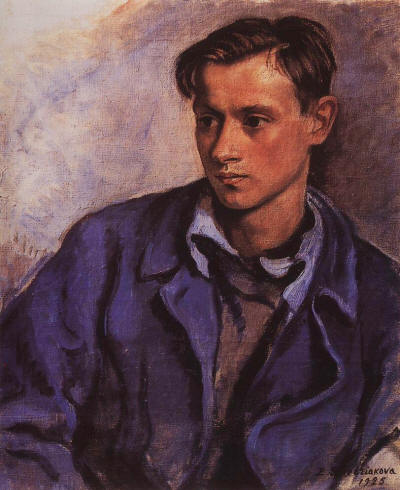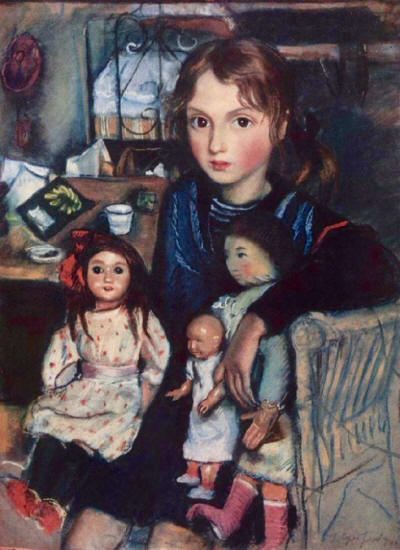Queer Places:
Cimetière de Sainte Genevieve des Bois
Sainte-Genevieve-des-Bois, Departement de l'Essonne, Île-de-France, France
 Zinaida
Yevgenyevna Serebriakova (née Lanceray; 12 December [O.S. 30 November] 1884 –
19 September 1967)[1]
was a Russian (later French) painter.
Sergey Rostislavovich Ernst
was the first to write monographs on the leading artists of the Russian
"Silver Age": Benua, Rerikh and Zinaida Serebriakova (who painted his portrait ant
that of his lover Dmitri Bouchéne).
Zinaida
Yevgenyevna Serebriakova (née Lanceray; 12 December [O.S. 30 November] 1884 –
19 September 1967)[1]
was a Russian (later French) painter.
Sergey Rostislavovich Ernst
was the first to write monographs on the leading artists of the Russian
"Silver Age": Benua, Rerikh and Zinaida Serebriakova (who painted his portrait ant
that of his lover Dmitri Bouchéne).

Dmitri Bouchéne by Zinaida Serebriakova

Sergey Rostislavovich Ernst by Zinaida Serebriakova

Her son Alexandre

Her daughters Tatiana and Ekaterina

Her daughter Ekaterina

Her daughter Ekaterina
Zinaida Serebriakova was born on the estate of Neskuchnoye near Kharkov
(now Kharkiv,
Ukraine) into one of the most refined and artistic families in the
Russian Empire.
She belonged to the artistic
Benois family. Her grandfather,
Nicholas Benois, was a famous architect, chairman of the Society of
Architects and member of the
Russian Academy of Science. Her uncle,
Alexandre Benois, was a famous painter, founder of the
Mir iskusstva art group. Her father,
Yevgeny Nikolayevich Lanceray,
was a well-known sculptor, and her mother, who was Alexandre Benois' sister,
had a talent for drawing. One of Zinaida's brothers,
Nikolay Lanceray, was a talented architect, and her other brother,
Yevgeny Yevgenyevich Lanceray, had an important place in Russian and
Soviet art as a master of monumental painting and
graphic art. The Russian-English actor and writer
Peter Ustinov was also related to her.
In 1900 she graduated from a women's
gymnasium (equivalent to grammar school or high school), and entered the
art school founded by
Princess Maria Tenisheva. She studied under
Repin in 1901, and under
portrait
artist
Osip Braz between 1903 and 1905. In 1902–1903 she spent time in Italy, and
from 1905 to 1906 she studied at the
Académie de la Grande Chaumière in Paris.
In 1905, she married her first cousin, Boris Serebriakov, the son of
Evgenyi's sister, and took his surname. Boris went on to become a railroad
engineer.
From her youth onwards, Zinaida Serebriakova strove to express her love of
the world and to show its beauty. Her earliest works, Country Girl
(1906,
Russian Museum) and Orchard in Bloom (1908, private collection),
speak eloquently of this search, and of her acute awareness of the beauty of
the Russian land and its people. These works are études done from nature, and
though she was young at the time, her extraordinary talent, confidence and
boldness were apparent.
Broad public recognition came with Serebriakova's self-portrait
At the Dressing-Table (1909,
Tretyakov Gallery), first shown at a large exhibition mounted by the
Union of Russian Artists in 1910. The self-portrait was followed by
Girl Bathing (1911, Russian Museum), a portrait of Ye.K. Lanceray
(1911, private collection), and a portrait of the artist's mother
Yekaterina Lanceray (1912, Russian Museum), already mature works, strict
in composition.
She joined the
Mir iskusstva movement in 1911, but stood out from the other members
of the group because of her preference for popular themes and because of the
harmony, plasticity and generalized nature of her paintings.
In 1914–1917, Zinaida Serebriakova was in her prime. During these years she
produced a series of pictures on the theme of Russian rural life, the work of
the peasants and the Russian countryside which was so dear to her heart:
Peasants (1914–1915, Russian Museum), Sleeping Peasant Girl
(private collection).
The most important of these works was Bleaching Cloth (1917,
Tretyakov Gallery), which revealed Zinaida Serebriakova's striking talent as a
monumental artist. The figures of the peasant women, portrayed against the
background of the sky, gain majesty and power by virtue of the low horizon.
When in 1916 Alexander Benois was commissioned to decorate the
Kazan Railway Station in Moscow, he invited Yevgeny Lanceray,
Boris Kustodiev,
Mstislav Dobuzhinsky, and Zinaida Serebriakova to help him. Serebriakova
took on the theme of the
Orient:
India, Japan,
Turkey, and
Siam are
represented allegorically in the form of beautiful women. At the same time she
began compositions on subjects from classical mythology, but these remained
unfinished.
At the outbreak of the
October Revolution in 1917, Serebriakova was at her family estate of
Neskuchnoye, and suddenly her whole life changed. In 1919 her husband Boris
died of typhus
contracted in
Bolshevik jails. She was left without any income, responsible for her four
children and her sick mother. All the reserves of Neskuchnoye had been
plundered, so the family suffered from hunger. She had to give up oil painting
in favour of the less expensive techniques of charcoal and pencil. This was
the time of her most tragic painting,
House of Cards, which depicts her four orphaned children.
She did not want to switch to the
futurist style popular in the art of the early Soviet period, nor paint
portraits of
commissars,
but she found some work at the
Kharkov Archaeological Museum, where she made pencil drawings of the
exhibits. In December 1920 she moved to her grandfather’s apartment in
Petrograd. After the
October Revolution, inhabitants of private apartments were forced to share
them with additional inhabitants, but Serebriakova was lucky - she was
quartered with artists from the
Moscow Art Theatre. Thus, Serebriakova's work during this period focuses
on theatre life. Also around this time, Serebriakova's daughter, Tatiana,
entered the academy of ballet, and Serebriakova created a series of pastels on
the
Mariinsky Theater.
In the autumn of 1924, Serebriakova went to Paris, having received a
commission for a large decorative mural. On finishing this work, she intended
to return to the
Soviet Union, where her mother and the four children remained. However,
she was not able to return, and although she was able to bring her younger
children, Alexandre and Catherine, to Paris in 1926 and 1928 respectively, she
could not do the same for her two older children, Evgenyi and Tatiana, and did
not see them again for many years.
After this, Zinaida Serebriakova traveled a great deal. In 1928 and 1930
she traveled to Africa, visiting
Morocco.
She was fascinated by the landscapes of northern Africa and painted the
Atlas mountains, as well as
Arab women and
Africans in ethnic clothing. She also painted a cycle devoted to
Breton
fishermen. The salient feature of her later landscapes and portraits is the
artist's own personality — her love of beauty, whether in nature or in people.
In 1947, Serebriakova at last took French citizenship, and it was not until
Khruschev's
Thaw that the Soviet Government allowed her to resume contact with her
family in the Soviet Union. In 1960, after 36 years of forced separation, her
older daughter, Tatiana (Tata), was finally allowed to visit her. At this
time, Tatiana was also working as an artist, painting scenery for the
Moscow Art Theatre.
Zinaida Serebriakova's works were finally exhibited in the Soviet Union in
1966, in Moscow,
Leningrad, and
Kiev, to great acclaim. Her albums sold by the millions, and she was
compared to
Botticelli and
Renoir. However, although she sent about 200 of her works to be shown in
the Soviet Union, the bulk of her work remains in France today.
Zinaida Serebriakova died in Paris on 19 September 1967, at the age of 82.
She is buried in Paris, at
the Russian cemetery at
Sainte-Geneviève-des-Bois, with her son, the painter
Alexandre Serebriakoff.
My published books:


BACK TO HOME PAGE

- https://en.wikipedia.org/wiki/Zinaida_Serebriakova
 Zinaida
Yevgenyevna Serebriakova (née Lanceray; 12 December [O.S. 30 November] 1884 –
19 September 1967)[1]
was a Russian (later French) painter.
Sergey Rostislavovich Ernst
was the first to write monographs on the leading artists of the Russian
"Silver Age": Benua, Rerikh and Zinaida Serebriakova (who painted his portrait ant
that of his lover Dmitri Bouchéne).
Zinaida
Yevgenyevna Serebriakova (née Lanceray; 12 December [O.S. 30 November] 1884 –
19 September 1967)[1]
was a Russian (later French) painter.
Sergey Rostislavovich Ernst
was the first to write monographs on the leading artists of the Russian
"Silver Age": Benua, Rerikh and Zinaida Serebriakova (who painted his portrait ant
that of his lover Dmitri Bouchéne).







